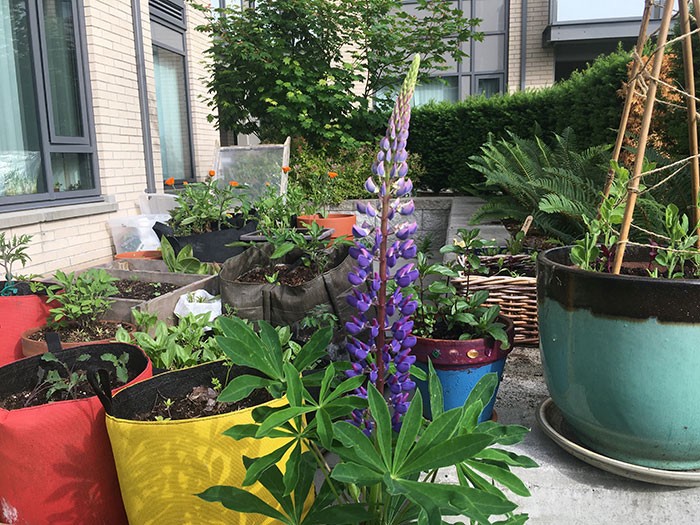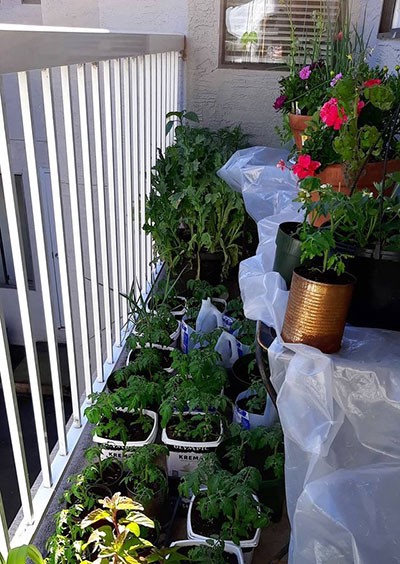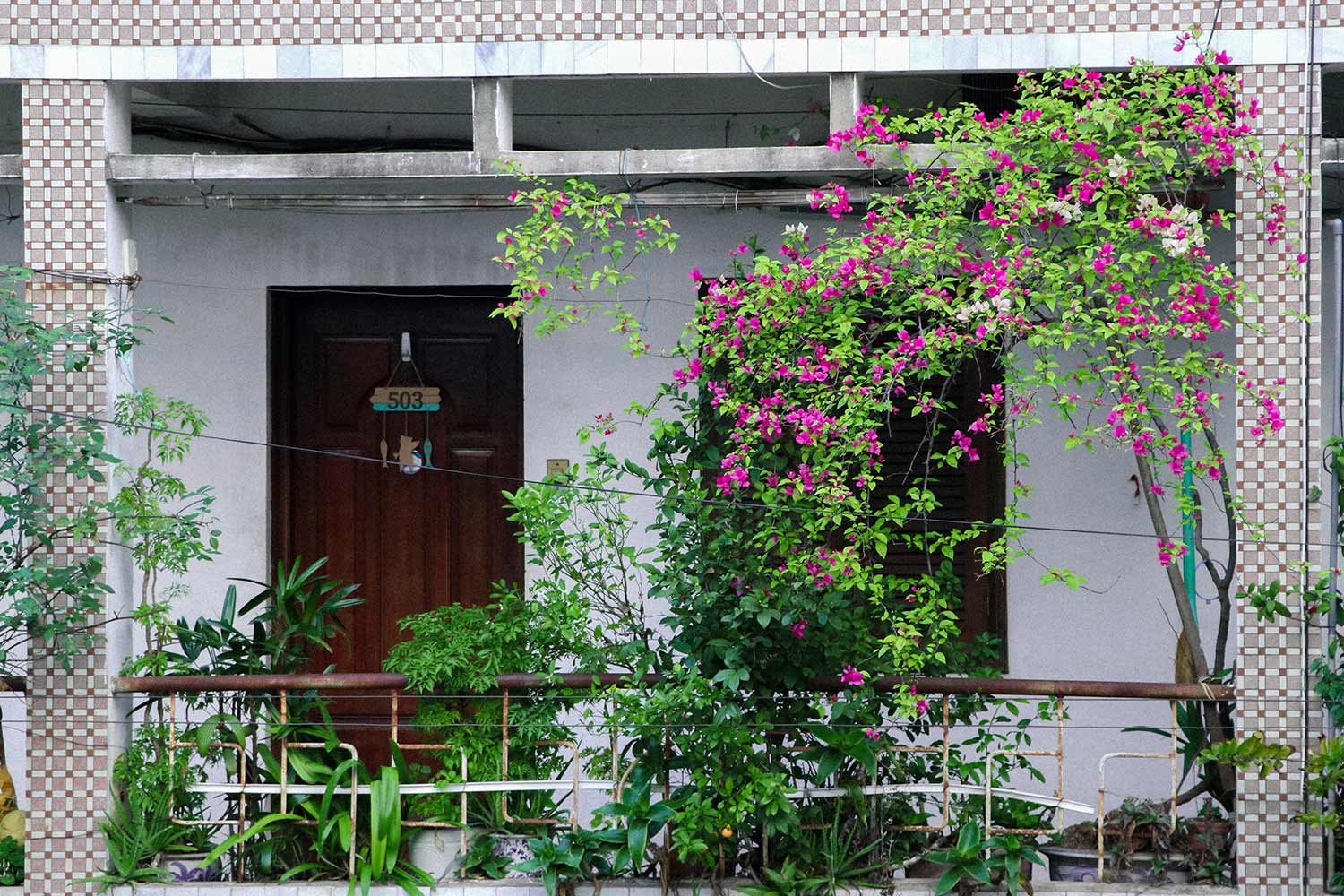When it Comes to Tiny Gardens, We Need to Think Big
Cities promote community gardens, but where's the support for those gardening on patios and balconies?
A balcony garden in Hanoi, Vietnam.
When I first moved into my apartment, the wait time for a plot in the nearby community gardens was longer than I expected to stay in the area, so I didn’t bother applying. Three years later, I am still there, but the wait list has gotten much longer. Fortunately, I have a large patio and have been able to grow a variety of plants in containers. Though my harvest is limited by lack of sunlight, it gives me a great deal of pleasure and satisfaction to grow food for my family and see the insects, birds, and tree frogs who visit my garden every day.
That said, container gardening in an environmentally responsible way can be challenging. Unlike in community gardens — where certain resources are provided for shared use — balcony and patio gardeners are on their own. Experts recommend partially or completely replacing potting soil every year to replenish nutrients and minimize disease. If you have to do this using bagged soil, it quickly becomes expensive and generates a lot of plastic waste.

The author’s patio garden
This past spring though, I had an idea: what if I could refresh the soil in my pots by paying for a share of the compost that would be delivered to the community garden around the corner from me? This would be more convenient, cost-effective, and environmentally friendly.
I sent an email to the community centre coordinating the compost delivery, asking whether they could order extra so nearby balcony and patio gardeners like me could benefit from the bulk purchase. I emphasized that I was ready to pay for my share, and that it would decrease the amount of plastic waste generated in our neighbourhood.
This was not the first time I had identified a collective problem and proposed a simple collective solution, only to have it reframed as an individual problem.
I was disappointed but not surprised when the community gardens coordinator said this would not be possible. She suggested I drive 30 kilometres to our regional landfill and composting centre to fill my buckets. This was not the first time I had identified a collective problem and proposed a simple collective solution, only to have it reframed as an individual problem. Putting aside the question of how to choose between reducing my plastic waste or avoiding the emissions associated with driving, what if I didn’t own a car? The coordinator was trying to help, but such “solutions” gloss over the inequities experienced by gardeners living in apartments and condos with no access to collective resources.
The artistry of balcony gardening
My friend Mel Cookson started gardening on her small balcony last summer. She is an artist and herbalist living with multiple chronic health conditions, and her garden is a model of waste-free growing. It consists mainly of cherry tomatoes grown from seeds she saved from last year’s harvest, and herbs and flowers she rescued on their way to the compost at her local garden centre.

Mel’s 40 tomato plants grow in yogurt containers saved since the beginning of the pandemic.
Her 40 tomato plants grow in square, 2-litre yogurt containers she has been saving since the pandemic began. They are packed closely together in rows the length of her balcony. Earlier in the season, she had emptied the soil from last year’s pots and painstakingly mixed it with new soil and compost, bought in plastic bags.
Mel’s art practice often makes use of recycled textiles, and she approaches her garden with the same creativity and environmental ethos. Packaging is not garbage, she says, but a resource that, if treated with care, may be useful in the future. The plastic bags that once held the potting soil are neatly stacked on a shelf with her other gardening supplies, ready to serve as vessels for future soil mixing.
Growing connections with nature
It may be too much to expect all balcony gardeners to go to the lengths that Mel does to reduce waste. At least, it is if communities don’t provide them with support. The tools that allow gardeners to make their own soil and fertilizer, and start their own plants — composters, greenhouses, cold frames, etc. — all take up space container gardeners don’t have. At the same time, because limited space often corresponds with limited sunlight, balcony and patio gardeners tend to get a smaller harvest. Collective solutions to these difficulties could increase the number of people gardening in an environmentally beneficial way, and help build a culture of environmental awareness and connection to nature.
When soil is brought home in plastic bags and cannot be renewed through natural processes, gardeners miss an opportunity to learn how micro-organisms sustain soil health. When I can’t bear to let any of my spinach or kale plants flower and go to seed because my harvest is already small, I miss witnessing the insects and birds that might otherwise visit my blooming greens.
And when I buy vegetable starts from a garden centre, instead of growing my own from seed, it’s easy to ignore the agricultural workers who cared for the seedlings but were likely underpaid to keep prices low.
Collective solutions
Mel tells me that — particularly during the pandemic, when she has had to spend more time at home — her garden has been a sanctuary. It provides her with physical and emotional sustenance, a chance to reconnect with her love of plants, which is what she feels originally enabled her healing after years of struggling with addiction. I am happy that she has the creativity and energy to do this for herself. But imagine if the responsibility she takes for her own well-being was answered by an equitable distribution of gardening amenities? In other words, what if individual health and environmental health were part of the same collective project?
I ask Mel what she thinks of the idea that balcony and patio gardeners should have the opportunity to share bulk deliveries of soil or compost. “That would make a lot of sense,” she says. “It would be the sign of a healthy city if everyone had access to that.”
Imagine how different our cities would be if more of us saw ourselves as active participants in the environment, rather than mere occupants?
Fortunately, we are not starting from zero with this kind of thing. Community gardens are a good example of how people living in condos and apartments can take part in larger, environmentally beneficial processes. These plots provide gardeners with precious space for cultivation as well as the opportunity to share bulk soil deliveries, make compost, and exchange plants and materials with other gardeners.
Unfortunately, we need many, many more community gardens — not only in parks, but also in innovative forms and settings, such as on rooftops, or using vertical gardening structures.
Other collective amenities could potentially be provided to container gardeners using spaces smaller than those required for community gardens. For example, in south Montreal, there is a community greenhouse that grows seedlings and provides educational programming to residents in the surrounding neighbourhoods who want to grow their own food. When I lived in Glasgow, Scotland, we took our food waste across the street to a community space that included several composters. We helped with their upkeep and when we needed compost for our small garden, we helped ourselves.
Investing in these kinds of shared amenities would make gardening more accessible and encourage people to connect with their neighbours — something that can be daunting for those of us who don’t have a fence to chat over.
Propagating plants, saving seeds, and making compost are activities that take time and effort, but they have broader social and cultural impacts. Imagine how different our cities would be if more of us saw ourselves as active participants in the environment, rather than mere occupants? Every gardener willing to put in a bit of extra effort deserves to experience this — to feel that what they are doing is part of something bigger, and that how they do it matters.
